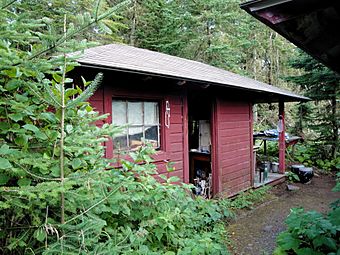Tobin Harbor Historic District facts for kids
Quick facts for kids |
|
|
Tobin Harbor Historic District
|
|

Edwards Store House
|
|
| Location | Isle Royale National Park, Michigan |
|---|---|
| NRHP reference No. | 100004256 |
| Added to NRHP | August 5, 2019 |
The Tobin Harbor Historic District is a unique group of old vacation homes and a fishing business. It's located on several small islands at the northeast end of Isle Royale in Michigan. This area was added to the National Register of Historic Places in 2019 because of its important history.
Contents
A Look Back in Time
Tourism on Isle Royale started way back in the late 1800s. Steamship companies, which ran big boats, began telling people about how beautiful the area was.
Early Days of Tourism
Around 1900, a fisherman named Gus Mattson started letting guests stay at his fishing spot. This was on Minong Island in Tobin Harbor. Over the next ten years, many small cottages and guest houses were built nearby.
In 1906, Gus Mattson sold his resort on Minong Island. Three men from Calumet, Michigan bought it. They called it the Tobin's Harbor Summer Resort. Later, it was known as the "Minong Lodge." More resorts opened, and small summer communities grew in the area. This continued until the late 1920s.
Changes and the National Park
However, cars became very popular, and fewer people traveled by steamship. This made Isle Royale harder to reach. The number of visitors to the island started to go down.
The people who owned resorts on the island wanted a national park to be created. They hoped this would bring more tourists. In 1936, the government began buying private land on Isle Royale. Their goal was to create a national park.
The National Park Service took over some of the resorts. But as tourism changed, these resorts slowly closed. Many of their buildings were removed. Some of the remaining structures are now very old and falling apart. However, some are still used by the children of the original owners. They have a special agreement to keep using them.
What You'll Find There
The Tobin Harbor Historic District has 13 groups of buildings. These include 12 private vacation spots, called "camps," and one fishing business.
Typical Camp Features
The camps in the Tobin Harbor Historic District are usually a small collection of simple buildings. They often have a main house, one or two guest cabins, and a small outdoor toilet (called a privy). Sometimes there are other buildings too.
These homes are for seasonal use, meaning people only stay there during certain times of the year. Inside, they are often unfinished. They use wood stoves for heat and usually do not have electricity or indoor plumbing.
The buildings are generally small and made of wood. They have flat or overlapping wooden siding. Their roofs are either pointed (gabled) or sloped on all sides (hipped). They are covered with asphalt. Many have a large front porch that goes across the whole front of the building. These porches often have a great view of the water. The windows are usually double-hung, meaning they slide up and down. The buildings sit on foundations made of concrete blocks, stone, or logs.
The Camps and Fishery
Here are some of the important places in the district:
- Mattson Fishery: This includes two homes, a privy, a fish house, a dock, and several storage buildings. It is now very old and falling apart.
- Snell Camp: This camp has a cottage, a guest house, a store house, and a "writing shack." Most of these buildings are still in great shape and look much like they did long ago.
- Siefert Camp: This includes a cottage, a storage building, a privy, and a dock. Most of these buildings are still in great shape.
- Connolly Camp: This camp has a cottage, a guest house, a dock, and a privy. Most of these buildings are still in great shape.
- Kemmer Camp: This includes a home, a guest house, a store house, a boat house, a privy, a dock, and concrete steps. These buildings are now used by park staff and are in excellent condition.
- Beard Camp: This camp has a cottage, a storage building, and a privy. All of these buildings are still in great shape.
- Edwards Camp: This includes a cottage, a dining room, a privy, and a store house. All of these buildings are still in great shape.
- Merritt Camp: This camp has a main cottage, three guest cottages, a privy, a woodshed, and a dock. Most of these buildings are still in great shape.
- Stack/Wolbrink Camp: This includes a cottage, a guest house, a privy, and a stone wall. All of these buildings are still in great shape.
- Gale Camp: This camp has a cottage, a guest cottage, a tool shed/wash house, a privy, and a dock. Most of these buildings are still in great shape.
- How Camp: This includes a cottage and a guest cabin. All of these buildings are still in great shape.
- Dassler Camp: This camp has a cottage, a guest house, a boathouse, and a privy. Most of these buildings are still in great shape.
- Savage Camp: This includes a boat house and a storage shed. These buildings are now very old and falling apart.
- Minong Lodge Cabin: This is the only cabin left from the larger Minong Lodge complex. It is now very old and falling apart.



